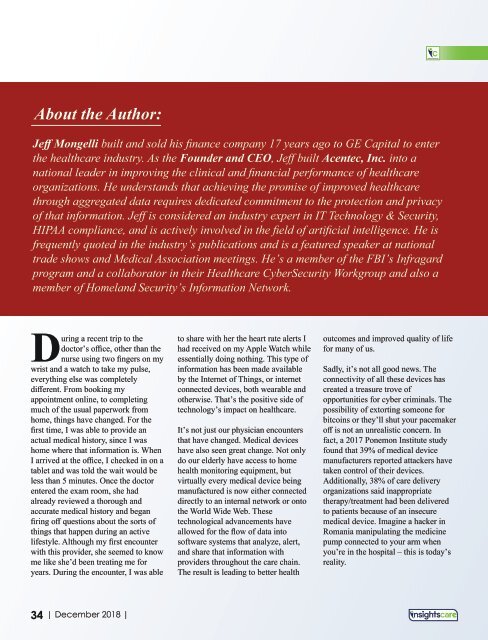Cycle Management Final File optimize
In a pursuit to acknowledge the revolution some of these companies are bringing to the existing revenue cycle segment in healthcare, we bring to you the special edition, titled “The 10 Best Revenue Cycle Management Solution Providers 2018”. It highlights the pioneers in this industry as well as their contribution to augment the existing workflow.
In a pursuit to acknowledge the revolution some of these companies are bringing to the existing revenue cycle segment in healthcare, we bring to you the special edition, titled “The 10 Best Revenue Cycle Management Solution Providers 2018”. It highlights the pioneers in this industry as well as their contribution to augment the existing workflow.
You also want an ePaper? Increase the reach of your titles
YUMPU automatically turns print PDFs into web optimized ePapers that Google loves.
About the Author:<br />
Jeff Mongelli built and sold his finance company 17 years ago to GE Capital to enter<br />
the healthcare industry. As the Founder and CEO, Jeff built Acentec, Inc. into a<br />
national leader in improving the clinical and financial performance of healthcare<br />
organizations. He understands that achieving the promise of improved healthcare<br />
through aggregated data requires dedicated commitment to the protection and privacy<br />
of that information. Jeff is considered an industry expert in IT Technology & Security,<br />
HIPAA compliance, and is actively involved in the field of artificial intelligence. He is<br />
frequently quoted in the industry’s publications and is a featured speaker at national<br />
trade shows and Medical Association meetings. He’s a member of the FBI’s Infragard<br />
program and a collaborator in their Healthcare CyberSecurity Workgroup and also a<br />
member of Homeland Security’s Information Network.<br />
uring a recent trip to the<br />
Ddoctor’s office, other than the<br />
nurse using two fingers on my<br />
wrist and a watch to take my pulse,<br />
everything else was completely<br />
different. From booking my<br />
appointment online, to completing<br />
much of the usual paperwork from<br />
home, things have changed. For the<br />
first time, I was able to provide an<br />
actual medical history, since I was<br />
home where that information is. When<br />
I arrived at the office, I checked in on a<br />
tablet and was told the wait would be<br />
less than 5 minutes. Once the doctor<br />
entered the exam room, she had<br />
already reviewed a thorough and<br />
accurate medical history and began<br />
firing off questions about the sorts of<br />
things that happen during an active<br />
lifestyle. Although my first encounter<br />
with this provider, she seemed to know<br />
me like she’d been treating me for<br />
years. During the encounter, I was able<br />
to share with her the heart rate alerts I<br />
had received on my Apple Watch while<br />
essentially doing nothing. This type of<br />
information has been made available<br />
by the Internet of Things, or internet<br />
connected devices, both wearable and<br />
otherwise. That’s the positive side of<br />
technology’s impact on healthcare.<br />
It’s not just our physician encounters<br />
that have changed. Medical devices<br />
have also seen great change. Not only<br />
do our elderly have access to home<br />
health monitoring equipment, but<br />
virtually every medical device being<br />
manufactured is now either connected<br />
directly to an internal network or onto<br />
the World Wide Web. These<br />
technological advancements have<br />
allowed for the flow of data into<br />
software systems that analyze, alert,<br />
and share that information with<br />
providers throughout the care chain.<br />
The result is leading to better health<br />
outcomes and improved quality of life<br />
for many of us.<br />
Sadly, it’s not all good news. The<br />
connectivity of all these devices has<br />
created a treasure trove of<br />
opportunities for cyber criminals. The<br />
possibility of extorting someone for<br />
bitcoins or they’ll shut your pacemaker<br />
off is not an unrealistic concern. In<br />
fact, a 2017 Ponemon Institute study<br />
found that 39% of medical device<br />
manufacturers reported attackers have<br />
taken control of their devices.<br />
Additionally, 38% of care delivery<br />
organizations said inappropriate<br />
therapy/treatment had been delivered<br />
to patients because of an insecure<br />
medical device. Imagine a hacker in<br />
Romania manipulating the medicine<br />
pump connected to your arm when<br />
you’re in the hospital – this is today’s<br />
reality.<br />
34 | December 2018 |
















